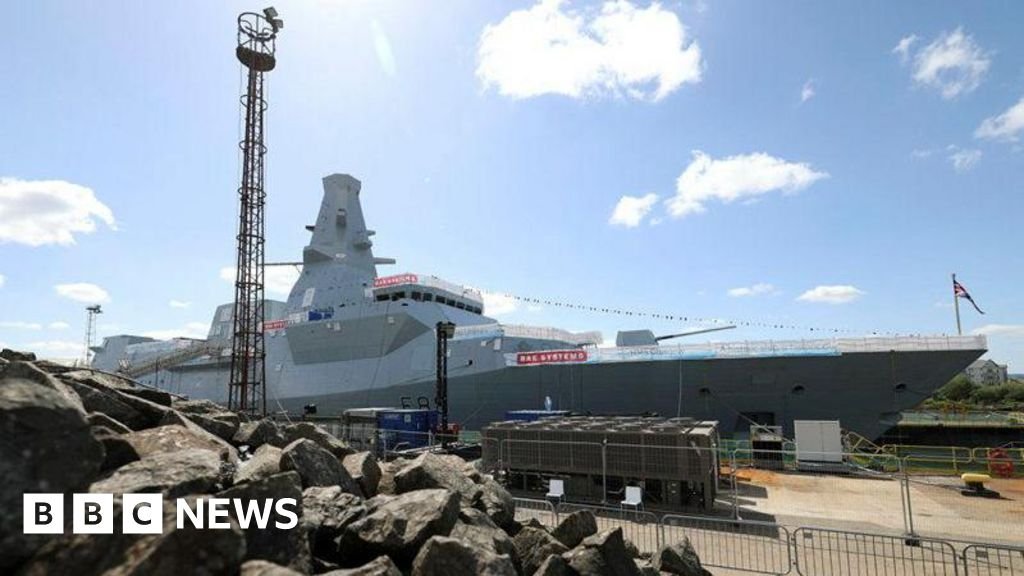Business
Rachel Reeves is under immense pressure. She must not waste her chance to ‘go big’ | Heather Stewart

It’s back to school this week for MPs and government ministers – and few can be facing a more challenging new term than Rachel Reeves.
After being moved to tears in the unforgiving glare of the cameras before the summer break, the chancellor’s allies say she is returning to the frontline with a renewed sense of purpose. She is ready, as the kids would say, to “lock in”.
But team Reeves is also well aware of the scale of the economic and political obstacles ahead. Most pressing, yet out of the chancellor’s hands, is the Office for Budget Responsibility’s (OBR) summer “supply stocktake” of its economic model.
As we reported in June, this looks likely to see the OBR move its key productivity forecast closer to the less-positive consensus. Given the crucial importance of productivity in determining economic growth, this shift could create a £20bn headache for the Treasury.
The downgrade – not anything Labour has actually done – is likely to be the biggest factor pushing Reeves off track from her fiscal rules.
That creates a formidable challenge in explaining what has gone awry – and why she needs to come back with more tax increases, after last year’s historic £40bn budget package.
Expect to hear much more of the kind of language Reeves used in her recent Guardian article, in which she argued that “if renewal is our mission and productivity is our challenge, then investment and reform are our tools”.
She does have a story to tell here: changing the fiscal rules to prioritise investment has allowed the Treasury to give the green light to scores of pro-productivity infrastructure projects (with the next expected to be Northern Powerhouse Rail).
In the same vein, expect tax rises to be badged as efficiency-enhancing, as well as revenue raising.
Officials do not yet know the scale of the fiscal gap they will need to fill – though they expect it to be large. Reeves’s decision to involve Torsten Bell, formally the pensions minister, in budget preparations, points to a willingness to think more radically.
Bell has argued in the past for changes to the taxation of unearned income, property wealth – which we know the Treasury are looking at closely – and pensions.
Reeves made moves in this direction last autumn, with changes to inheritance and capital gains taxes; but this budget must be the moment to “go big,” as Bell’s former boss Ed Miliband would put it. (Arguably, the moment was, in fact, last July, but here we are.)
Yet as she draws up her plans, Reeves must have her eye on at least three different audiences, each in their way as tough as the meanest girls in the dining hall.
The first, and most important, is the public, for whom the chancellor may be best known as the author of last year’s botched removal of the winter fuel allowance.
While she is claiming to have been “fixing the foundations” in her first year in the job, it may not feel like it for families facing resurgent inflation – which hits low earners hardest.
And unfortunately, “Labour crashed the economy”, while unfair, is a much cleaner explanation for fresh tax rises than, “the OBR has systemically overestimated productivity, which hasn’t recovered since the financial crisis”.
Reeves will need to convince cash-strapped voters she understands their struggles and has a plan to help.
after newsletter promotion
Also watching Reeves closely will be those behind her, in her own party. Once seen as a potential future leader, she is blamed by some Labour MPs for a series of dire missteps, including on winter fuel and the botched spring statement welfare cuts.
Keir Starmer’s decision to bring in the former Bank of England deputy governor Minouche Shafik as his economic adviser, and the senior Treasury civil servant Dan York-Smith as principal private secretary, appear to indicate a new determination in No 10 to shape the government’s economic project, instead of subcontracting it wholesale to Reeves.
Given the prime minister’s temperamental caution, these hires seem unlikely to presage any dramatic change of course. But they do raise the prospect of cracks emerging between No 10 and No 11, which rarely ends well.
Reeves’s third audience is among what her battle-scarred Labour predecessor Denis Healey called “the faceless men” (and these days, women) managing the “atomic cloud of footloose funds” in financial markets.
Talk of an IMF bailout is well wide of the mark but with debt interest expected to cost the taxpayer more than £100bn this year, even modest moves in government bond markets can be extremely costly.
Judging by the bond sell-off in July when Reeves’s tears were read as a sign that she was on the way out, investors are minded to trust her – or at least, more than any potential alternative.
But to keep the support of this tough crowd, tax rises will have to be straightforward (and big) enough to close any fiscal gap convincingly; yet calibrated not to put the kibosh on growth or jack up inflation.
Given the 10 weeks’ formal notice the Treasury gives the OBR of the budget date, it cannot now happen until November.
Reeves will want to set some parameters in public long before that, to contain what has already become frenzied speculation; but she would be wise not to waste what may be Labour’s best crack at reforming our out-of-kilter tax system.
Business
Norway signs £10bn deal for anti-submarine warships built in UK | BAE Systems

Norway has agreed a £10bn deal for anti-submarine warships that will be built in the UK, as the two countries plan joint operations in northern Europe to deal with increased Russian activity.
The Ministry of Defence (MoD) said the agreement to build Type 26 frigates was the UK’s biggest ever warship export deal by value, and Norway’s biggest defence procurement deal.
It said that overall it would provide a £10bn boost to the UK economy and support 4,000 jobs across the UK “well into the 2030s”.
The Type 26 frigates will be built at the BAE Systems shipyards in the Govan area of Glasgow, which employ 2,000 staff and are already constructing eight of the warships for the Royal Navy.
“This £10bn deal is what our plan for change is about,” said the UK prime minister, Keir Starmer. “Creating jobs, driving growth and protecting national security for working people. The export of our world-leading Type 26 frigates will do exactly that, supporting well-paid jobs up and down the United Kingdom, from apprentices to engineers.”
It is estimated that the shipbuilding programme will support 432 businesses, including 103 in Scotland, 47 in the north-west of England and 35 in the West Midlands.
The deal also signals a strengthening of a long-term strategic relationship with Norway, as part of which a combined fleet of 13 frigates will operate jointly in northern Europe.
Eight of the frigates will be British and “at least” five will be Norwegian, with the joint operation designed to “significantly strengthen Nato’s northern flank”.
“This historic defence deal deepens our strategic partnership,” said John Healey, the defence secretary. “With Norway, we will train, operate, deter and – if necessary – fight together. Our navies will work as one, leading the way in Nato, with this deal putting more world-class warships in the north Atlantic to hunt Russian submarines, protect our critical infrastructure and keep both our nations secure.”
Concerns over critical infrastructure around Europe have been raised on multiple occasions in the last year, after the alleged sabotage of the Baltic gas pipeline and undersea internet cables between Finland and Estonia.
Norway was the only other country to participate in the UK carrier strike group’s full deployment this year, and it also collaborates with the UK and Nato partners to safeguard critical undersea infrastructure in northern Europe.
“Norway and the United Kingdom are close allies with common interests and strong bilateral ties,” said Jonas Gahr Støre, Norway’s prime minister. “I am confident that the strategic partnership with the UK for purchasing, developing and operating frigates is the right decision.”
The Scottish secretary, Ian Murray, said the decision showed the “tremendous success” of Scotland’s shipbuilding industry and was an example of another “defence dividend” for the country.
The Type 26 frigate features sophisticated weapons, and advanced sensors and communications. Its design enables the warship to be upgraded to “counter emerging threats”, according to the MoD’s statement announcing the deal.
Charles Woodburn, the chief executive of BAE Systems, said: “The Norwegian government’s decision reflects its confidence in British industry’s ability to deliver a superior anti-submarine warfare platform, together with systems and equipment, that will support its future maritime security and reinforce its position within Nato.”
Business
UK agrees £10bn deal to supply Norway with warships

The UK and Norway have agreed a £10bn deal under which Britain will supply the Norwegian navy with at least five new warships.
The agreement involving Type 26 frigates will be the UK’s “biggest ever warship export deal by value”, the Ministry of Defence (MoD) said, while Norway said it would be its largest “defence capability investment” to date.
The government said the deal would support 4,000 UK jobs “well into the 2030s”, including more than 2,000 at BAE Systems’ Glasgow shipyards where the frigates will be built.
UK Prime Minister Sir Keir Starmer said the agreement would “drive growth and protect national security for working people”.
“This success is testament to the thousands of people across the country who are not just delivering this next generation capabilities for our Armed Forces but also national security for the UK, our Norwegian partners and Nato for years to come,” he added.
The deal is also expected to support more than 400 British businesses, including 103 in Scotland, the MoD said.
The agreement represents a victory for the British government and defence industry over France, Germany and the United States – which were also being considered by Norway as possible vendors.
It will create a combined UK-Norwegian fleet of 13 anti-submarine frigates – eight British and five Norwegian vessels – to operate jointly in northern Europe, significantly strengthening Nato’s northern flank.
The warships will be constructed at the BAE systems yard in the Govan area of Glasgow, where frigates for the Royal Navy are currently being built.
Scottish Secretary Ian Murray said the choice of the UK “demonstrates the tremendous success of our shipbuilding industry and showcases the world-class skills and expertise of our workforce on the Clyde”.
Norway’s Prime Minister Jonas Gahr Støre, who informed Sir Keir of the decision to select the UK in a phone call on Saturday night, said the partnership “represents a historic strengthening of the defence cooperation between our two countries”.
Støre said the government had weighed two questions in its decision: “Who is our most strategic partner? And who has delivered the best frigates?… The answer to both is the United Kingdom.”
The Type 26 frigates purchased by the Royal Norwegian Navy will be as similar as possible to those used by their British counterparts, and have the same technical specifications.
They are specifically designed to detect and track enemy submarines and engage them in combat if necessary, with deliveries are expected to begin in 2030.
UK Defence Secretary John Healey said: “For over 75 years, Britain and Norway have stood together on Nato’s northern and north-eastern frontiers, keeping the UK and Europe safe. This historic defence deal deepens our strategic partnership.
“With Norway, we will train, operate, deter, and – if necessary – fight together.
“Our navies will work as one, leading the way in Nato, with this deal putting more world-class warships in the North Atlantic to hunt Russian submarines, protect our critical infrastructure, and keep both our nations secure.”
Business
First the great migration, now the big hold: why workers are staying put | US small business

The tide has turned. The great migration – when the shift to remote work prompted people to quit their jobs in droves – is officially over. Now comes the big hold.
According to a new survey from consulting firm Robert Half, 73% of respondents – workers at companies – said they plan to stay in their current roles through 2025. They gave reasons like having “positive company culture” and “feeling professionally fulfilled” or “being well compensated” at their current job. But there’s also a fourth reason why so many are staying put: the job market isn’t great and people are worried.
Job growth is significantly down. Job openings fell again to under 7.5m last month, a level that’s 4m below the openings available back in 2022. Wage gains during that same period had fallen from 6.7% to 4.1%.
Microsoft, AT&T, JP Morgan, Amazon and other companies are mandating their employees to return to their offices or lose their jobs. AI is already replacing workers at tech companies, Wall Street firms and retailers and some fear greater job losses in the not too distant future. Other cost cutting measures are leading big brands like Citi, Accenture, Tesla and Intel and other corporate giants to lay off tens of thousands of workers.
And what a great opportunity for small businesses!
For example, there’s my friend in Illinois. He has over 100 employees in his office. For years, he’s been spending half his days just walking around and talking to them. Telling them how important they are. Checking in on their lives and families. Asking them what they’re doing and what problems they’re having. Imagine working for that guy. Someone who genuinely cares about his workers. His turnover’s low. His retention is high.
Or another client of mine in Pennsylvania who allocates a big piece of his operating budget every year to employee technical training. Fear AI? “No way”, he tells me. “I want my people to embrace it! They need to learn about all the AI features in our software applications so that they can not only get more work done for me during the day but have a more balanced life themselves.” Did I mention that he gets workforce development money from his state that pays for this extra training? Now you know.
Another client of mine gives employees a $1,000 educational “credit” to use however they want. “They can learn origami or take a knitting class for all I care,” she said to me. “Becoming a better person makes you a better worker too.” Not coincidentally, she also enjoys the tax deductions allowed for providing this benefit.
There are other tax benefits that small business owners can use to recruit and retain all this available talent for healthcare, childcare, for hiring workers who were formerly incarcerated, off welfare or out of the military.
In the midst of all this job chaos, small business hiring and employment has remained constant. The latest Small Business Employment Watch report from Paychex, the giant HR and payroll processing firm, found that in July hiring among those companies with less than 50 employees “remained steady” which, according to the company’s CEO “speaks to the resiliency of small businesses given the amount of uncertainty they faced so far this year”.
Ever since I can remember my small business clients have complained about competing with big companies and the government for talent. Well, now the tide has turned. Big companies are laying off people by the tens of thousands. Governments are cutting their headcounts. The labor market is softening. But small businesses – who already employ half of this country’s workers – are still hiring and always looking for talent. The softening job market is a great opportunity for them. And for many workers.
-
Tools & Platforms3 weeks ago
Building Trust in Military AI Starts with Opening the Black Box – War on the Rocks
-

 Business2 days ago
Business2 days agoThe Guardian view on Trump and the Fed: independence is no substitute for accountability | Editorial
-

 Ethics & Policy1 month ago
Ethics & Policy1 month agoSDAIA Supports Saudi Arabia’s Leadership in Shaping Global AI Ethics, Policy, and Research – وكالة الأنباء السعودية
-

 Events & Conferences3 months ago
Events & Conferences3 months agoJourney to 1000 models: Scaling Instagram’s recommendation system
-

 Jobs & Careers2 months ago
Jobs & Careers2 months agoMumbai-based Perplexity Alternative Has 60k+ Users Without Funding
-

 Funding & Business2 months ago
Funding & Business2 months agoKayak and Expedia race to build AI travel agents that turn social posts into itineraries
-

 Education2 months ago
Education2 months agoVEX Robotics launches AI-powered classroom robotics system
-

 Podcasts & Talks2 months ago
Podcasts & Talks2 months agoHappy 4th of July! 🎆 Made with Veo 3 in Gemini
-

 Podcasts & Talks2 months ago
Podcasts & Talks2 months agoOpenAI 🤝 @teamganassi
-

 Mergers & Acquisitions2 months ago
Mergers & Acquisitions2 months agoDonald Trump suggests US government review subsidies to Elon Musk’s companies

